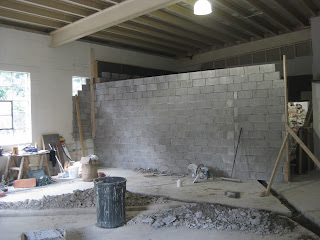
Summer is starting to sneak up on us in New York City and the temperature in the cheese cave is starting to rise. In the previous years I would move all the cheeses upstate to a cooler place now. But this year I would like to keep them in the city as I expect to spend more time here. I would like to tend to the cheeses more regularly.
Last year most of the cheeses grew very wild rinds and were badly infested with cheese mites due to very high humidity. Having the cheese here allows me to monitor the conditions in the cave and keep the rind development and cheese mites under control.
Having said all this, climate control in the cave is of the essence. A while ago I read about a device called
Coolbot in an article about cheese caves. I had always thought climate control would be very elaborate and expensive. The systems I have seen are large and pricey. Granted the caves are usually larger but a conventional system for my cave would still be complicated and expensive. This little device seemed to be the answer. As said on the
website; the Coolbot turns any off the shelf air conditioner into a turbo charged cooling machine.
I ordered the
Coolbot several weeks ago and installed it using a small frigidaire air conditioner I had lying around. This was during the first heat wave in New York. It ran for several days. To my dismay nothing happened, no drop in temperature, nothing. Initially I thought the ac unit wasn't compatible with the
Coolbot. According to the
Coolbot manual, most fridigaire air conditioners have metal frost sensors which don't work well with the
Coolbot. After closer inspection I realized that the air conditioner was broken. I felt relieved. I had almost lost my trust in the
Coolbot.
I read the manual again (I have read it several times during my trials) and went on a search for a small LG, Samsung or Haier air conditioner. These are the recommended brands. I needed a unit which was physically small as well as small in BTU's. As the whole cave is formed by at least a foot thick concrete, the only space for the unit is the entrance. Any unit too wide would block the entrance. After some research I found a small Haier, about 18 inches wide, perfect for my application.
After I installed the unit I waited with great anticipation. The temperature in the cave dropped a little but not significantly. I changed the settings on the
Coolbot several times, checked the connections between the air conditioner and the
Coolbot and read the manual over and over again. The
Coolbot wasn't the miracle I had hoped for.
Several weeks past and the outside temperature dropped again and the temperature in the cave wasn't as pressing. But recently the weather has warmed up again and without a doubt, soon it will be sweltering hot in the city. I directed my attention again to the climate in the cave. This had to work.
After reading the manual again I realized that insulation plays an important role. I had not realized that the concrete worked as a cold sink. The concrete of the roof of the cave felt definitely warm. After insulating this with 2 inch styrofoam, the temperature in the cave dropped by 5 degrees after a day. This was a real achievement. I regained my trust in the
Coolbot, maybe it could be the miracle device. With the help of the temperature outside, I could now cool the cave to 56 F. But with rising temperature in the city again, it was time for more insulation. Today I insulated most of the other walls with 2 inch styrofoam. Whether this will be is enough, time will tell. I am confident now that I can reach my desired temperature. The
Coolbot might just be a small miracle.



















































